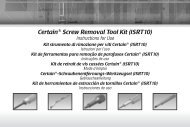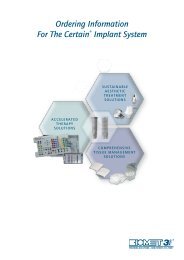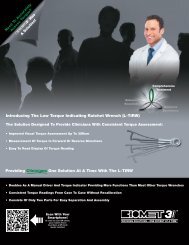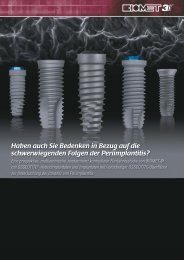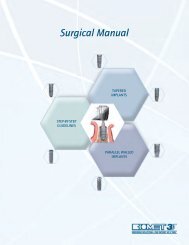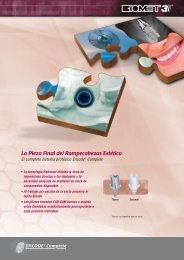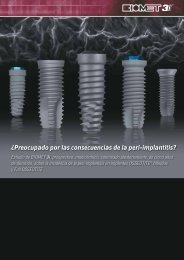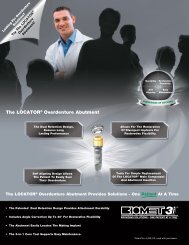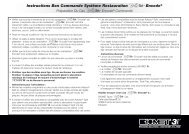Winter 2007 - Biomet 3i
Winter 2007 - Biomet 3i
Winter 2007 - Biomet 3i
Create successful ePaper yourself
Turn your PDF publications into a flip-book with our unique Google optimized e-Paper software.
L I T E R A T U R E R E V I E WRoughness Characterization Of Surface WithDiscrete Crystalline Deposition Of Nanometer-Scale CaP CrystalsPrabhu Gubbi, PhDZachary Suttin, MSMEAlexis Goolik, MSCE–BMEA Poster Presentation To The Academy Of Osseointegration Annual Meeting,March 8-10, <strong>2007</strong>, In San Antonio, TexasThe objective of this study was to characterize the surface roughnessof polished titanium disks with nanometer-scale calcium phosphate (CaP)crystals deposited by a new proprietary surface treatment called DiscreteCrystalline Deposition (DCD ).Materials And MethodsTi (Ti-6Al-4V-ELI) disks, 20mm in diameter and 1.5mm in thickness, weremachined and polished on one side to a mirror finish (Control group). Agroup of polished disks were deposited with nano-scale CaP crystals usingthe DCD process (CaP group). Atomic Force Microscopy (AFM), widelyemployed to quantify surface measurement parameters of surfaces withnanometer topographical characteristics, was used to obtain surface maps.Using AFM (Model MMAFM-2, Digital Instruments) in tapping mode, twodisks from each group were analyzed with various spot sizes. The datawere post-processed using a 3x3 low filter, with background subtractionand line by line averaging with a 3x3 degree polynomial. The key roughnessparameters obtained were Sq (root mean square variation over the surface)and Sa (absolute mean height deviation).ResultsThe calculated overall means for the Control group (N = 20 data points)were Sq = 5.04nm ± 3.62nm and Sa = 3.29nm ± 2.37nm. For the CaP group(N = 18 data points), the corresponding values were Sq = 19.3nm ± 6.4nmand Sa = 14.8nm ± 5.1nm.ConclusionThe surface roughness characterization using AFM suggests that thedeposition of nanometer-scale CaP crystals over a polished surfacesubstantially increases the topographical complexity.These atomic force microscopy (AFM) images compare a polished titaniumdisk surface (left) to the complex topography resulting from the DCDof nanometer-scale CaP crystals (right).Discrete Calcium Phosphate Nanocrystalline Deposition EnhancesOsteoconduction On Titanium-Based Implant SurfacesVanessa C. Mendes, DDS, MSc, PhDJohn E. Davies, BDS, PhD, DSc, FSBEA Poster Presentation To The Academy Of Osseointegration Annual Meeting,March 8-10, <strong>2007</strong>, In San Antonio, TexasThe surface microtopography of implants influences biological response inthe periimplant compartment by enhancing early periimplant healing andpromoting increased Bone-To-Implant-Contact (BIC). A recent technology hasbeen developed, in which nano-structured calcium phosphate (CaP) crystalsare deposited onto microtopographically complex titanium surfaces, addinganother level of complexity to them. Our study was aimed at analyzing andcomparing osteoconduction, measured asBIC, on micro and nano-textured titaniumimplant surfaces, using a bone ingrowthchamber model.Back-scattered imaging modeclearly distinguishes between theT-Plant chamber wall and thesurrounding, and ingrown, bone.Custom T-shaped bone ingrowth chamberswere fabricated from either commerciallypure titanium (cp) or titanium alloy (Ti64).All chambers were dual acid etched (DAE)and half of them were modified by aDiscrete Crystalline Deposition (DCD)of CaP on the surface. Four groups weregenerated (cp, cpDCD, Ti64, Ti64DCD) with a total of 130 implants placedinto both femora of male Wistar rats for nine days. After harvesting, sampleswere resin embedded and back-scattered electron images of multiple planesof the implant chambers were produced. Quantitative analysis of BIC wasperformed on a total of 1087 micrographs.This bone ingrowth model was effective to demonstrate the osteoconductivebehavior along surfaces with differences in complexity of their microtopography.Newton-Coles numerical integration formula was used to determine boneingrowth as a function of anatomical location of the chamber opening andthe implant surface. All groups exhibited osteoconduction, but Ti64 groupsshowed a higher chance to grow more bone than cp, although this wasnot statistically significant. However, osteoconduction on both DCD groups(26.95% cpTiDCD, 29.73% Ti64DCD) was statistically significant whencompared to the results of non-DCD groups (12.01% cpTi, 16.97% Ti64).The proximal opening of the chamber consistently showed significantlyhigher bone ingrowth (17.49% cpTi, 30.37% cpTiDCD, 23.19% Ti64, 34.88%Ti64DCD) than the distal side (8.31% cpTi, 24.46% cpTiDCD, 12.60% Ti64,25.55% Ti64DCD).This can be explained by the direction of the predominant blood supply tothe distal femur. We conclude that the DCD enhanced osteoconduction duringearly stages of periimplant healing and that the anatomical location plays animportant role in bone growth in this model.9



